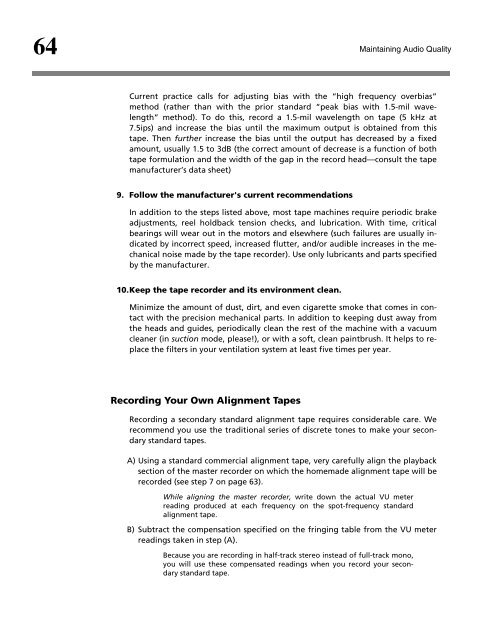Maintaining Audio Quality in the Broadcast Facility 2011 - Orban
Maintaining Audio Quality in the Broadcast Facility 2011 - Orban
Maintaining Audio Quality in the Broadcast Facility 2011 - Orban
You also want an ePaper? Increase the reach of your titles
YUMPU automatically turns print PDFs into web optimized ePapers that Google loves.
64<br />
<strong>Ma<strong>in</strong>ta<strong>in</strong><strong>in</strong>g</strong> <strong>Audio</strong> <strong>Quality</strong><br />
Current practice calls for adjust<strong>in</strong>g bias with <strong>the</strong> “high frequency overbias”<br />
method (ra<strong>the</strong>r than with <strong>the</strong> prior standard “peak bias with 1.5-mil wavelength”<br />
method). To do this, record a 1.5-mil wavelength on tape (5 kHz at<br />
7.5ips) and <strong>in</strong>crease <strong>the</strong> bias until <strong>the</strong> maximum output is obta<strong>in</strong>ed from this<br />
tape. Then fur<strong>the</strong>r <strong>in</strong>crease <strong>the</strong> bias until <strong>the</strong> output has decreased by a fixed<br />
amount, usually 1.5 to 3dB (<strong>the</strong> correct amount of decrease is a function of both<br />
tape formulation and <strong>the</strong> width of <strong>the</strong> gap <strong>in</strong> <strong>the</strong> record head—consult <strong>the</strong> tape<br />
manufacturer’s data sheet)<br />
9. Follow <strong>the</strong> manufacturer's current recommendations<br />
In addition to <strong>the</strong> steps listed above, most tape mach<strong>in</strong>es require periodic brake<br />
adjustments, reel holdback tension checks, and lubrication. With time, critical<br />
bear<strong>in</strong>gs will wear out <strong>in</strong> <strong>the</strong> motors and elsewhere (such failures are usually <strong>in</strong>dicated<br />
by <strong>in</strong>correct speed, <strong>in</strong>creased flutter, and/or audible <strong>in</strong>creases <strong>in</strong> <strong>the</strong> mechanical<br />
noise made by <strong>the</strong> tape recorder). Use only lubricants and parts specified<br />
by <strong>the</strong> manufacturer.<br />
10. Keep <strong>the</strong> tape recorder and its environment clean.<br />
M<strong>in</strong>imize <strong>the</strong> amount of dust, dirt, and even cigarette smoke that comes <strong>in</strong> contact<br />
with <strong>the</strong> precision mechanical parts. In addition to keep<strong>in</strong>g dust away from<br />
<strong>the</strong> heads and guides, periodically clean <strong>the</strong> rest of <strong>the</strong> mach<strong>in</strong>e with a vacuum<br />
cleaner (<strong>in</strong> suction mode, please!), or with a soft, clean pa<strong>in</strong>tbrush. It helps to replace<br />
<strong>the</strong> filters <strong>in</strong> your ventilation system at least five times per year.<br />
Record<strong>in</strong>g Your Own Alignment Tapes<br />
Record<strong>in</strong>g a secondary standard alignment tape requires considerable care. We<br />
recommend you use <strong>the</strong> traditional series of discrete tones to make your secondary<br />
standard tapes.<br />
A) Us<strong>in</strong>g a standard commercial alignment tape, very carefully align <strong>the</strong> playback<br />
section of <strong>the</strong> master recorder on which <strong>the</strong> homemade alignment tape will be<br />
recorded (see step 7 on page 63).<br />
While align<strong>in</strong>g <strong>the</strong> master recorder, write down <strong>the</strong> actual VU meter<br />
read<strong>in</strong>g produced at each frequency on <strong>the</strong> spot-frequency standard<br />
alignment tape.<br />
B) Subtract <strong>the</strong> compensation specified on <strong>the</strong> fr<strong>in</strong>g<strong>in</strong>g table from <strong>the</strong> VU meter<br />
read<strong>in</strong>gs taken <strong>in</strong> step (A).<br />
Because you are record<strong>in</strong>g <strong>in</strong> half-track stereo <strong>in</strong>stead of full-track mono,<br />
you will use <strong>the</strong>se compensated read<strong>in</strong>gs when you record your secondary<br />
standard tape.



![[PDF] Using the ITU BS.1770-2 and CBS Loudness Meters ... - Orban](https://img.yumpu.com/50629372/1/190x245/pdf-using-the-itu-bs1770-2-and-cbs-loudness-meters-orban.jpg?quality=85)






![[PDF] Optimod-FM Feature Comparison - Orban](https://img.yumpu.com/41741615/1/190x245/pdf-optimod-fm-feature-comparison-orban.jpg?quality=85)






